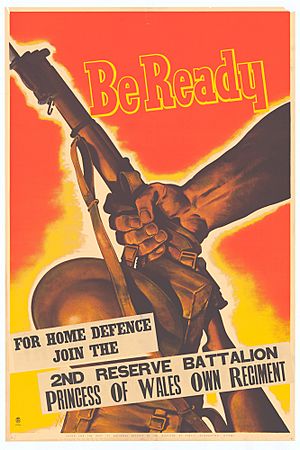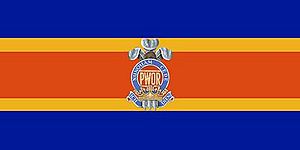Princess of Wales' Own Regiment facts for kids
Quick facts for kids The Princess of Wales' Own Regiment |
|
|---|---|

Cap badge of The Princess of Wales' Own Regiment
|
|
| Active | January 16, 1863 – present |
| Country | |
| Branch | Primary Reserves |
| Type | Line Infantry |
| Role | Light Role |
| Size | One battalion |
| Part of | Royal Canadian Infantry Corps |
| Garrison/HQ | Kingston |
| Nickname(s) | The P-Dubs |
| March | Quick: The Buffs |
| Commanders | |
| Current commander |
LCol Dave Beyer, Commanding Officer |
The Princess of Wales' Own Regiment (PWOR) is a special group of soldiers in Canada's military. They are part of the Primary Reserves, which means they are trained soldiers who serve part-time. The PWOR is an infantry regiment, focusing on ground combat. They are based in Kingston, Ontario.
Contents
History of the PWOR
The regiment started on January 16, 1863. It was first called the 14th Battalion Volunteer Militia Rifles of Canada. This group was formed by combining seven smaller rifle companies from Kingston, Ontario.
Soon after, the Prince of Wales married Princess Alexandra of Denmark. The regiment asked for and received permission to change its name. This is how they became The Princess of Wales’ Own Regiment.
Early Challenges and Service
In 1866, the regiment was called to active duty during the Fenian Raid. This was when some Irish extremists attacked Canada to try and pressure Great Britain. The PWOR served near Niagara and later in Cornwall. A special band mace in the museum remembers their service in Cornwall.
In 1885, the PWOR was activated again during the Riel Rebellion. They hoped to go to the West to fight. Instead, they were given guard duties in Kingston. They protected places like Tete-du-Pont Barracks (now Fort Frontenac) and Fort Henry.
Serving in the Boer War
The Second Boer War began in South Africa in 1899. Many members of the 14th Battalion joined other units to fight. Because of their help, "South Africa 1900" became their first battle honour. A battle honour is a special award for bravery in battle.
One PWOR officer, Major Wallace Bruce Matthews Carruthers, went to South Africa on his own. He was later asked to join the regular army. When he returned to Canada, he helped start the Royal Canadian Corps of Signals.
The Great War (World War I)
When World War I started in 1914, many PWOR members joined quickly. About 80 men formed a group led by Captain George T. Richardson. He was the first PWOR officer to die in the war. A stadium in Kingston is named after him. This group joined the 2nd Battalion Canadian Expeditionary Force (CEF).
At the same time, the 21st Battalion, CEF was formed in Kingston. Its commanding officer was Lieutenant-Colonel St Pierre Hughes from the PWOR. The PWOR also sent soldiers to other battalions like the 59th, 146th, and 253rd Battalions.
The 21st Battalion fought for three years on the front lines. They earned eighteen Battle Honours. Many items from the 21st Battalion, including their flags (Colours), are in the regimental museum. The 21st Battalion's mascot was a white goat named Nan. She lived at the Royal Military College of Canada after the war.
After the war, in 1920, the 14th Battalion Rifles was renamed. This allowed them to carry the Battle Honours and Colours of the 21st Battalion, CEF.
Alliances and World War II
On July 15, 1926, the Princess of Wales’ Own Regiment became allied with the South Lancashire Regiment. This British regiment also had battle honours like Louisburg and Niagara. Later, the South Lancashire Regiment joined with others to form The Queen's Lancashire Regiment.
During the Second World War, the PWOR itself was not sent overseas as a whole unit. This was because of the many soldiers they lost in World War I. Instead, they provided a full company of soldiers to the Stormont, Dundas and Glengarry Highlanders.
A PWOR officer, Lieutenant-Colonel GH Christiansen, led the Glens on D-Day. Another PWOR officer, Brigadier-General Douglas Gordon Cunningham, commanded their brigade.
In June 1942, the 1st battalion PWOR was formed. It served in Sherbrooke, Quebec and Debert, Nova Scotia. They helped defend Canada's east coast. In total, the regiment sent 1500 men to active service. This included one Brigadier, four Colonels, and eight Lieutenant-Colonels.
Recent History and Service
In 1963, the PWOR celebrated its 100th birthday. The City of Kingston gave them the "Freedom of the City." They also received new flags (Colours) that showed the badge of the Stormont, Dundas and Glengarry Highlanders. This honored the PWOR members who served with that regiment in World War II.
The regiment faced challenges in the 1970s and 1980s. But in 1978, it was again made a major unit. The PWOR has always done well in competitions, including sports and shooting. In 1895, a PWOR member represented Canada at a major shooting event called Bisley.
Today, the regiment includes men and women from all walks of life. They are students, police officers, and farmers. PWOR members have served on peacekeeping missions in Cyprus and the former Yugoslavia. They have also served in combat missions in Afghanistan during Operation Medusa.
On May 4, 2013, the Princess of Wales' Own Regiment marched through Kingston. This was to celebrate their "Freedom of the City." The PWOR continues to be an important part of Canada's army. They are ready to serve as a top infantry unit if called upon.
Operational History
Fenian Raids Service
The battalion was called to active duty on March 8, 1866. They remained on duty until March 31, 1866.
South African War Service
The regiment did not fight as a whole unit in the Boer War. However, many of its members volunteered to join other Canadian groups that fought there.
Great War Service
On August 6, 1914, parts of the regiment were called to active service. They helped with local protection duties.
The 21st Battalion (Eastern Ontario), CEF was officially formed on October 14, 1914. They sailed to Britain on May 6, 1915. Then, they arrived in France on September 15, 1915. This battalion fought as part of the 4th Infantry Brigade, 2nd Canadian Division in France and Flanders until the war ended. The battalion was officially closed on August 30, 1920.
The 59th Battalion (Ontario), CEF was formed on April 20, 1915. They sailed to Britain on April 1, 1916. There, they provided new soldiers for the Canadian forces fighting in the field. On July 6, 1916, its soldiers joined the 39th Battalion, CEF. This battalion was officially closed on May 21, 1917.
The 253rd (Queen's University) Highland Battalion, CEF was formed on May 1, 1916. They started recruiting soldiers in late 1916. They sailed to Britain on April 29, 1917. On May 18, 1917, its soldiers joined the 5th Reserve Battalion, CEF. This was to provide more soldiers for the Canadian forces. The battalion was officially closed on December 8, 1917.
Second World War Service
Parts of the regiment were called to duty on August 26, 1939. They were then placed on active service on September 1, 1939. They were called The Princess of Wales' Own Regiment (Machine Gun), CASF (Details). Their job was local protection. These groups were officially closed on December 31, 1940.
The regiment provided No. 1 Company to The Stormont, Dundas and Glengarry Highlanders. This was for active service on May 24, 1940. The regiment later formed the 1st Battalion, The Princess of Wales' Own Regiment (Machine Gun), CASF, on May 12, 1942. It was renamed the 1st Battalion, The Princess of Wales' Own Regiment, CIC, CASF, on July 19, 1943. It served in Canada to defend the country. The battalion was officially closed on October 15, 1943.
War in Afghanistan Service
The regiment sent many of its soldiers to various special groups. These groups served in Afghanistan between 2002 and 2014. More than 20% of the regiment's soldiers took part.
Alliances
 United Kingdom - The Duke of Lancaster's Regiment (King's Lancashire and Border)
United Kingdom - The Duke of Lancaster's Regiment (King's Lancashire and Border)
Perpetuations: Keeping History Alive
"Perpetuation" means that the Princess of Wales' Own Regiment carries on the history and traditions of older military units. It's like they keep their spirit alive.
- War of 1812: The PWOR keeps the history of the Battalion of Incorporated Militia of Upper Canada, the 1st Regiment of Addington Militia, the 1st Regiment of Frontenac Militia and the 1st Regiment of Lennox Militia.
- The Great War: The PWOR also keeps the history of the 21st Battalion (Eastern Ontario), CEF, the 59th Battalion (Ontario), CEF and 253rd Battalion (Queen's University Highland), CEF.
Battle Honours and Special Awards
Battle honours are special awards given to military units for their bravery and success in battles or campaigns. They are often displayed on the unit's flags (colours). Honours in Bold Type are shown on the regimental flag.
War of 1812 Honours
- Defence of Canada – 1812–1815 – Défense du Canada
- Niagara
They also have a special award called Defence of Canada – 1812–1815 – Défense du Canada.
Boer War Honours
- South Africa, 1900
Great War Honours
- Mount Sorrel
- Somme, 1916, '18
- Flers–Courcelette
- Thiepval
- Ancre Heights
- Arras, 1917, '18
- Vimy, 1917
- Hill 70
- Ypres, 1917
- Passchendaele
- Amiens
- Scarpe, 1918
- Drocourt–Quéant
- Hindenburg Line
- Canal du Nord
- Cambrai, 1918
- Pursuit to Mons
- France and Flanders, 1915–18
Second World War Honours
They have a special award: the badge of the Stormont, Dundas and Glengarry Highlanders (SD&G Highrs), with the dates 1944–1945. This is for helping to form that unit for service in Europe.
War in Afghanistan Honours
- Afghanistan
Media and Books
Capt. Herbert W. McBride served with the 21st Battalion. He wrote two books about his experiences as a sniper and machine gunner during the Great War. These books are called "A Rifleman Went To War" and "The Emma Gees."
The PWOR Band
The PWOR Band is a pipe and drum band made up of volunteers. They are supported by the regiment. The band's goal is to keep the highland traditions alive for the PWOR. The PWOR Band has played at events like Remembrance Day Parades and the Canada Day Parade.
Memorials and Remembrance
In May 1917, officers of the 21st Battalion built a cross. This cross honored their friends who died fighting at Vimy Ridge. A carpenter named Private George Williams used wood from the battlefield to make the cross. It was ten feet tall and had a metal plaque. The plaque said, "In Memory of the Officers, NCOs and Men; 21st Canadian Infantry Battalion Killed in Action April 9th 1917."
The cross was first put up near Thelus, France. Later, it was moved to Sanctuary Wood, and then to the Royal Military College of Canada in the 1920s. From 1992-1994, the cross was fixed up. It was then moved inside the Regimental Armouries at 100 Montreal Street. The 21st Battalion cap badge is at its base. The regiment's battle honours surround it. Every April, during special services, the name of every 21st Battalion soldier killed at Vimy is read aloud.
The Princess of Wales' Own Regiment Military Museum
| Location | The Armouries 100 Montreal Street Kingston, ON K7K 3E8, Canada |
|---|---|
| Type | Regimental Museum |
This museum collects and protects military items related to the regiment. It also includes items from other military groups from Kingston. The museum shows these items to soldiers and the public. This helps everyone better understand Kingston's military history. The museum also teaches military history to soldiers and the public. The Kingston Armouries building is a special Classified Federal Heritage Building.
Ice Hockey Team
The regiment used to have its own senior ice hockey team. This team played in the Ontario Hockey Association. In 1908, they won the J. Ross Robertson Cup. Famous players like Hockey Hall of Fame members Captain George Richardson and Scotty Davidson played on this team.
Images for kids










